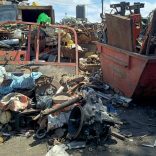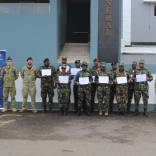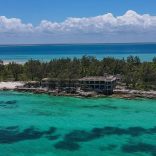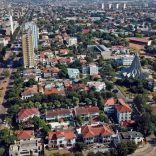Maputo inspects scrap yards in bid to crack down on manhole cover theft – photos
Southern Africa: Tropical Cyclone Kenneth flash update no. 7 – UN OCHA

Buildings damaged during Cyclone Kenneth are seen from the air in a village north of Pemba, Mozambique, May 1, 2019. Photo: Reuters
2 May 2019
HIGHLIGHTS
• More than 27,000 people have been reached with food assistance since Cyclone Kenneth made landfall on 25 April 2019.
• International deliveries of shelter supplies began to arrive in Pemba on 1 May 2019; more flights are scheduled in the days ahead.
• The number of people affected by Tropical Cyclone Kenneth has risen to more than 384,800, with an estimated 185,000 people affected in Comoros and at least 199,836 affected in Mozambique.
• The risk of water-borne diseases is high, with many areas still without access to clean water following the cyclone.
SITUATION OVERVIEW
The number of people impacted by Tropical Cyclone has risen as further information becomes available from affected areas.
In Mozambique some 199,836 people were recorded as affected as of 1 May, while the number of people affected in the Comoros is being reviewed and revised.
The risk of water and vector borne diseases is high due to water contamination and water shortages. In multiple locations in Ibo, Macomia and Quissanga districts, water supply has been damaged or destroyed. In Macomia town, for example, the water supply system is not functioning, and power remains cut.
Sanitation facilities have been destroyed in multiple locations, including household latrines, increasing the rate of open defecation.
Pemba is one of the most cholera-endemic areas in Mozambique and malaria is prevalent.
More than 7,000 pregnant women are reportedly at risk of unsafe childbirth in affected areas, according to UNFPA.
Tropical Cyclone Kenneth left a path of destruction, with more than 34,500 homes either totally destroyed (21,060) or partially destroyed (13,444) in Cabo Delgado alone.
Matemo
On Matemo Island, only a hospital, mosque and the bank building were left standing after the entire village was destroyed, according to Save the Children. Solar panels at the clinic were destroyed, leaving the hospital without cold-chain for vital vaccines.
People living on the island who lost their homes are sheltering out in the open, in broken buildings or in the hospital, according to the assessment team.
Farms – which were growing cassava and beans – have been destroyed and communities are living on dried fish which they had stored before the cyclone.
People are relying on mosquito nets for fishing, according to WFP.
Cyclone Kenneth is expected to impact food security in the months to come as it arrived during the main harvest, flattening crops yet to be harvested and spoiling food that had already been harvested.
More than 20,000 displaced people
More than 20,000 displaced people were staying in accommodation centres as of 1 May, with the largest number of people in accommodation centres in Quissanga (10,554), followed by Pemba (4,752), Mocimboa da Praia (1,750), Metuge (1,350), Palma (855), Macomia (422), Muidumbe (335) and Mecufi (20).
The Government has requested that schools that are serving as accommodation centres be deactivated to allow children to attend class, and displaced people currently sheltering in schools are being moved to churches and sport centres.
Literacy levels and language
Findings from a language mapping by Translators Without Borders (TWB) indicates that 81 per cent of women and 51 per cent of men are illiterate in Cabo Delgado province, while only 20 per cent of women and 42 per cent of men understand Portuguese. Makhuwa, Makonde, and Mwani are the main languages spoken at home.
To ensure life-saving information is accessed by people quickly, in their own language, TWB have recommended the use of short, simple, and clearly illustrated communication and information material, with pictures where possible.
Audio communication channels will be important to ensure effective reach to the communities.
Floods
The river basins of Messalo, Montepuez and Megaruma remain on red alert and flooding has been reported in the Cabo Delgado districts of Metuge and Mecufi. Water is receding in Pemba, but parts of the city remain with high levels of water.
Nampula
The number of affected people in Nampula is growing.
The northern part of Memba district is one of the most impacted areas and only accessible by air due to the flooding in Rio Lurio.
Humanitarian organisations are requesting an aerial survey as roads are cut.
Access
The road north from Macomia to Chai remains cut off for vehicle access. However, pedestrians are moving through the area.
At least 80 per cent (4 out of 5) of the bridges between Macomia junction and Mucojo have reportedly been destroyed or damaged.












Leave a Reply
Be the First to Comment!
You must be logged in to post a comment.
You must be logged in to post a comment.